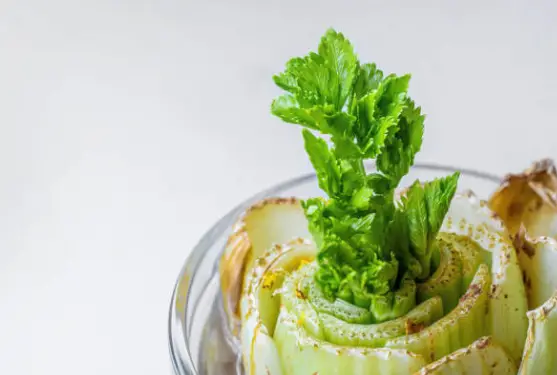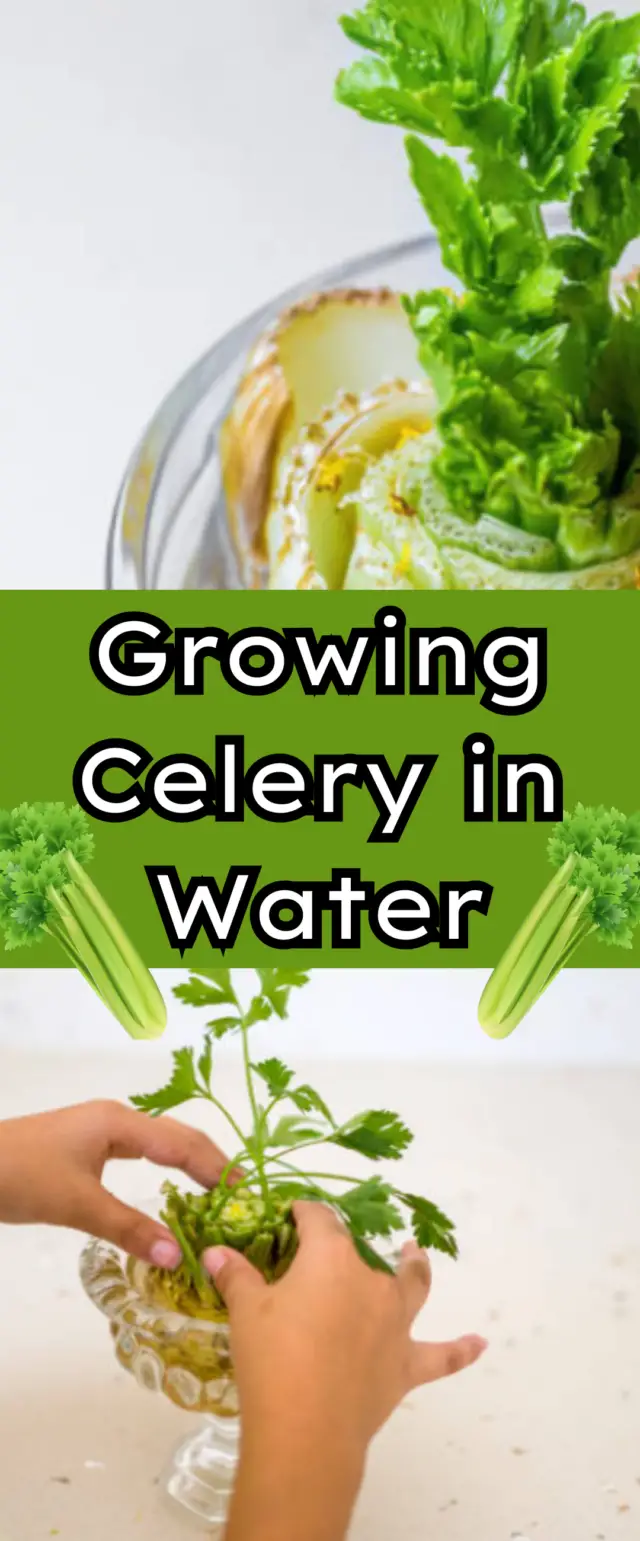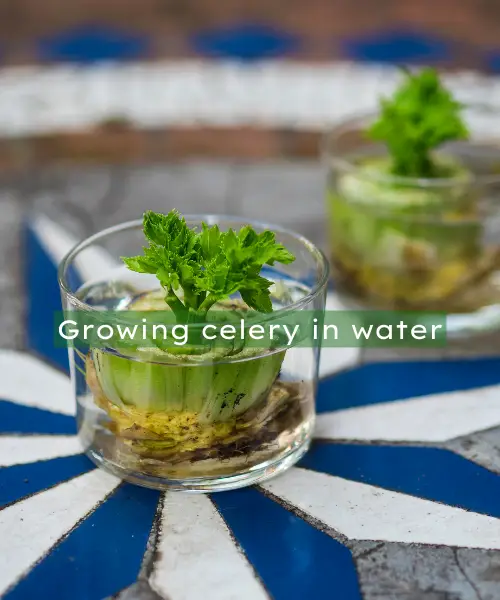If you love having fresh celery on hand but don’t have a garden or space for an outdoor vegetable patch, don’t worry; you can easily grow celery indoors with just water alone.
Growing celery in water is an excellent way to have a constant supply of this versatile vegetable for cooking, juicing, or snacking. It’s also a sustainable method that reduces food waste by allowing you to regrow celery from scraps instead of buying entire new bunches.
Let’s dive into the step-by-step process for cultivating celery hydroponically at home.
Why Grow Celery in Water?
There are several compelling reasons to try growing celery in water:

Space-Saving
Hydroponic celery doesn’t require any soil, so you can grow it just about anywhere—on a windowsill, counter, or shelf. This makes it an excellent option for urban gardeners or those with limited outdoor space.
Low-Maintenance
Unlike soil-based celery plants that need regular watering and monitoring, water-grown celery basically takes care of itself once established. As long as you keep the water reservoir topped up, your celery will thrive.
No Weeding or Pest Control
Hydroponic gardening eliminates the need for weeding since there is no soil for weeds to grow in. It also avoids many common garden pests that live in soil.
Uses up Scraps
Instead of tossing those celery base scraps in the compost, you can regrow a whole new celery plant from them in just water. This reduces food waste significantly.
Continuous Harvest
Since you can grow multiple celery plants at once, you’ll have a steady rotation of fresh celery to harvest as needed rather than having to buy it all at once.
Getting Started with Water-Grown Celery
To grow celery in water, you’ll need a few basic supplies:

Growing Celery in Water
- Celery base or scraps with leaf stalks attached (get a head start by using the leafy base from a store-bought celery bunch)
- A wide-mouth glass jar, vase, or bowl
- A plate, lid or mesh to cover the top
- Filtered water
- Sunny windowsills or grow lights
Once you have the supplies ready, follow these simple steps:
1. Prepare the Celery Base
Cut off the celery stalks about 2 inches above the base, leaving the root end intact. Make sure there are a couple of small leafy stalks still attached to the base.
2. Place in Container
Set the celery base upright in your glass container and fill with enough filtered water to cover about 1/3 of the base. The leaf stalk nubs should be above the water line.
3. Location and Light
Place the container in a spot that gets at least 6 hours of direct sunlight per day, such as a bright windowsill facing south or west. If you don’t have an ideal sunny window, set up some fluorescent grow lights.
4. Cover and Monitor
To prevent algae growth and keep dust out, cover the top of the container with a plate, lid, or mesh screen with holes poked in it for air circulation. Check the water level every few days and refill as needed with filtered water.
5. Be Patient
After about a week, you should start to see the inner celery stalks turning green and new leaves sprouting up from the middle of the base. Once the new growth is 5–6 inches tall, remove the cover and allow the celery to grow uncovered.
Caring for Your Hydroponic Celery
While regrowing plants hydroponically is pretty straightforward, there are a few tips to ensure your plants stay healthy:

Change the Water Regularly
About once a week, dump out the old water completely and give the container a quick rinse before refilling it with fresh, filtered water. This prevents bacteria buildup.
Prune Yellowing Stalks
Any yellow, wilted outer stalks should be snipped off near the base to direct the plant’s energy toward new inner growth.
Give it Nutrients
Every 2-3 weeks, add a small amount of liquid veggie fertilizer or compost tea to replenish nutrients in the water. Be careful not to overfeed.
Rotate for Even Growth
Turn the container a quarter turn every few days so all sides of the celery base can get equal light exposure and grow evenly.
Harvest in Moderation
Never remove more than 1/3 of the outermost celery stalks at once. This allows the inner stalks to continue maturing for future harvests.
Troubleshooting Common Issues

Growing Celery in Water
Leggy, Floppy Growth
If new celery stalks are growing tall and spindly, it need more light. Move to a sunnier spot or add supplemental grow lights.
Algae Growth
Green or white fuzz developing in the water indicates algae growth, usually caused by too much light exposure. Use an opaque container, keep it covered, and rinse more often.
Stunted Growth
Pale yellow leaves and minimal new growth is signs of nutrient deficiency. Feed with diluted fertilizer and make sure to refresh the water weekly.
Foul Smell
Any sour, rotten, or foul odors coming from the water mean it’s time for a complete water change to prevent harmful bacteria buildup.
With proper care, you can continuously harvest fresh celery for months by simply regrowing from the original base over and over again in water. Enjoy having this nutritious veggie on hand for cooking, crunching, and juicing!
Creative Ways to Use Hydroponic Celery
Once you get the hang of this space-saving growing method, you’ll have an abundance of crisp, flavorful celery at your fingertips. Get creative with all that fresh celery by trying out some of these tasty recipes and uses:
Homemade Celery Salt/Seasoning
Thinly slice and dehydrate celery leaves and stalks, then grind into a flavorful celery salt or seasoning blend to add to salads, eggs, soups, and more.
Celery Juice
Juicing celery is all the rage for its potential health benefits. With a steady, homegrown supply, you can enjoy nutrient-dense celery juice daily.
Celery Soup
Simmer down your hydroponic celery (stalks, leaves, and all) with vegetable broth, potatoes, and herbs for a nourishing hot or chilled celery soup.
Celery Pesto
Make a vibrant spring pesto with a twist by blending celery leaves, garlic, nuts, Parmesan, and olive oil to toss with pasta or spread on crostini.
Celery Salsa
Finely chop celery stalks and leaves and mix with jalapeños, onions, tomatoes, cilantro, and lime for a zesty, low-calorie salsa to scoop up with veggies or baked chips.
Celery Leaf Compound Butter
Let celery leaves steep in softened butter with garlic and herbs for an amazingly flavorful compound butter to melt over veggies, proteins, or bread.
Batch Cooking and Meal Prep
Having a steady supply of fresh celery at home makes healthy meal prep a breeze. Chop some up for soups, stews, stir fries, and more throughout the week.
Enjoy Fresh Celery Year-Round
Growing celery in water hydroponically is an ingenious way to have a constant supply of this versatile veggie on hand, no matter where you live or how much gardening space is available. Give it a try, and you’ll be amazed at how easy it is to grow your own celery indoors with just water and some ambient light. Your taste buds (and wallet) will thank you!




